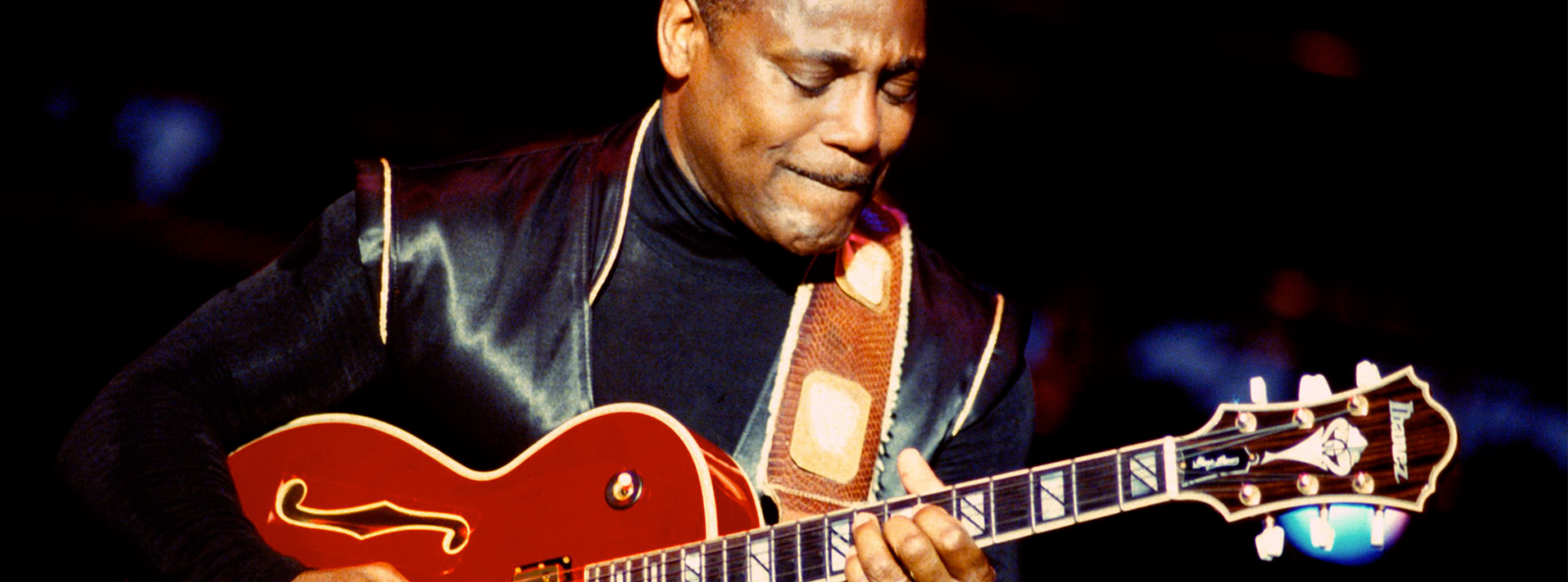Live and Dangerous: A Guitarist's Guide to Thin Lizzy's Seminal Album
Released in 1978, "Live and Dangerous" is a live album by the legendary Irish rock band Thin Lizzy. Recorded during their 1977 tour, it showcases the best of the band's live performances and features iconic guitarists Scott Gorham and Brian Robertson. It is still regarded as one of the greatest live rock recordings of all time and a snapshot of Thin Lizzy at their musical peak. In this Classic Album guitar course, expert tutor and true Thin Lizzy fan, Danny Gill teaches the guitar parts from this legendary recording. Experience the highs of The Rocker, through to the sombre tones of Still In Love With You and get closer to a true piece of hard rock history! Essential learning for every rock guitarist.
Live and Dangerous is steeped in duelling solos, harmony guitar melodies to die for and some of the best driving rock riffs ever written. This article will take you through the album track by track, highlighting the guitar techniques and scales used, and provide an insight into the incredible talents of these guitarists.
1. Jailbreak
"Jailbreak" kicks off the album with its signature power chords riff in the key of E minor. The guitar solo features a mix of E minor pentatonic and E blues scales, with a generous use of string bending and vibrato to create tension.
2. Emerald
"Emerald" is a hard-rocking tune in A minor. The main riff is based on the A Dorian mode, which gives it a Celtic edge. The dual-guitar harmonies and octaves bring a unique sound to the track, showcasing the band's prowess with dual-guitar harmonies.
3. Southbound
"Southbound" is a melodic track that features a mix of A major and A Mixolydian scales. Gorham and Robertson's guitar work shines in this song with their use of slides and double-stops to create a southern rock vibe.
4. Rosalie
"Rosalie" is a cover of the Bob Seger song and showcases the band's ability to transform a classic tune into a hard-rock anthem. The song's chord progression is based in the key of A major, and the guitar solo incorporates A major pentatonic and A Mixolydian scales with an abundance of pull-offs and hammer-ons.
5. Dancing in the Moonlight
"Dancing in the Moonlight" is a groovy, upbeat track in G major. The guitar work showcases the use of chord progressions and arpeggios to create a melodic foundation for the song.
6. Massacre
"Massacre" is a fast-paced, aggressive track that features the E Dorian scale. The song's structure is built around galloping rhythms and palm-muted riffs, creating a sense of urgency.
7. Still in Love With You
"Still in Love With You" is a slow, bluesy ballad in A minor. The guitar work in this song features emotional bluesy bends and vibrato in the solos, showcasing the guitarist's expressive capabilities. A Mixolydian and A minor pentatonic scales are used to create a melancholic atmosphere, while octave melodies add to the song's depth.
8. Johnny the Fox Meets Jimmy the Weed
This funky instrumental in E minor features a combination of E Dorian and E blues scales, giving it a gritty, urban feel. The guitar work includes syncopated rhythms and double-stop bends, showcasing the versatility of the guitarists.
9. Cowboy Song
"Cowboy Song" is a classic Thin Lizzy track that combines elements of hard rock and country. The song is in the key of E major and features the use of E Mixolydian and E major pentatonic scales. The guitar work includes hybrid picking and pre-bends to create a unique blend of genres.
10. The Boys Are Back in Town
Arguably Thin Lizzy's most famous song, "The Boys Are Back in Town" is a hard-rock anthem in G major. The guitar work features power chords, open-string riffs, and intricate dual-guitar harmonies, creating an infectious energy.
11. Don't Believe a Word
"Don't Believe a Word" is a bluesy rock tune in C# minor that showcases the band's ability to write catchy riffs and memorable melodies. The guitar work includes the use of C# minor pentatonic and C# blues scales, with hammer-ons, pull-offs, and string bending techniques.
12. Warrior
"Warrior" is an epic track that showcases Thin Lizzy's unique blend of hard rock and Celtic influences. The song is in the key of E minor and features the use of E Aeolian and E Phrygian scales. Gorham and Robertson's guitar work includes the use of legato techniques and trills to create a sense of movement and intensity.
13. Are You Ready
"Are You Ready" is a high-energy track in A major that highlights the band's ability to create infectious riffs and memorable hooks. The guitar work includes the use of A major pentatonic and A Mixolydian scales, with alternate picking and palm-muting techniques to create a driving rhythm.
14. Suicide
"Suicide" is a powerful track in E minor that showcases Thin Lizzy's hard-rock prowess. The guitar work features the use of E minor pentatonic and E blues scales, with pinched harmonics and unison bends adding to the song's intensity. The solo section incorporates tremolo picking and dive-bombs to create an aggressive and expressive sound.
15. Sha La La
"Sha La La" is a lively track in A major that showcases Thin Lizzy's ability to create catchy melodies and groovy rhythms. The guitar work features the use of A major pentatonic and A Mixolydian scales, with finger-picking and sweep-picking techniques adding to the song's texture.
16. Baby Drives Me Crazy
"Baby Drives Me Crazy" is a fun, up-tempo track in E major that highlights Thin Lizzy's playful side. The guitar work includes the use of E major pentatonic and E Mixolydian scales, with rakes and two-handed tapping techniques creating a lively and energetic feel.
17. The Rocker
"The Rocker" is a classic Thin Lizzy track that showcases the band's hard-rock roots. The song is in the key of E major and features the use of E major pentatonic and E Mixolydian scales. The guitar work incorporates whammy bar tricks and pick slides to create a raw and powerful sound.
Lead Guitarists: Scott Gorham and Brian Robertson
"Live and Dangerous" wouldn't be the same without the incredible talents of lead guitarists Scott Gorham and Brian Robertson. Their dual-guitar harmonies, masterful use of scales, and innovative techniques set Thin Lizzy apart from other bands of their era. Gorham and Robertson's ability to seamlessly blend hard rock, blues, and Celtic influences created a unique sound that has stood the test of time and inspired countless guitarists.
By exploring the range of techniques and scales used throughout "Live and Dangerous," guitarists can gain a deeper appreciation for Thin Lizzy's innovative approach to guitar playing. This album not only showcases the band's incredible live performances but also serves as an inspiration for guitarists looking to expand their own playing repertoire.
PERFORMANCE FOOTAGE NOT INCLUDED WITH THIS COURSE
Guitar Techniques Used in "Live and Dangerous"
Throughout the album, Gorham and Robertson employ various guitar techniques that contribute to Thin Lizzy's distinctive sound. Some of these techniques include:
- Vibrato
- Alternate Picking
- Legato
- Tapped Harmonics
- Double-Stop Bends
- Unison Bends
- Pinched Harmonics
- Trills
- Tremolo Picking
- Chord Progressions
- Arpeggios
- Dive-Bombs
- Harmonics
- Pull-Offs
- Power Chords
- Palm Muting
- Barre Chords
- Two-Handed Tapping
- Sweep Picking
- Rakes
- Finger-Picking
- Hybrid Picking
- Pre-Bends
- Hammer-Ons
- Double-Stops
- Slides
- Sustain
- Pick Slides
- String Bending
- Syncopated Rhythms
- Open-String Riffs
- Whammy Bar Tricks
- Bluesy Bends
- Octave Melodies
- Galloping Rhythms
- Dual-Guitar Harmonies
- Arpeggiated Chord Progressions
- Chromaticism
- Altered Tunings
Click on any of the links to view more in depth information about these techniques, and to find more Licklibrary lessons to develop these skills.
About The Tutor
Tutor Profile
Danny Gill
Danny Gill is, without a doubt, the most loved tutor by our community. With an incredible array of DVDs and web lessons for LickLibrary covering a wide variety of topics all of which he covers with incredible detail, it's no wonder he carries as much respect as he does. As...



